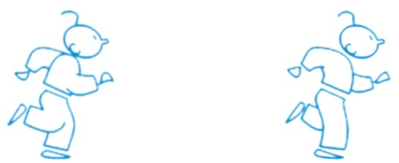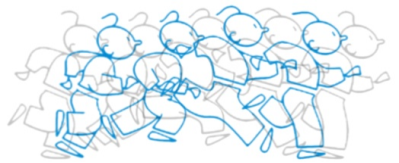Introduction
The traditional animation process often follows on those steps:
- First, key images are drawn to outline the scene's global movement, define the number of images it will require and a get rough idea of the animation's timing. In the example below, our character is running from the left to the right of the Canvas. Two key images have been drawn:

- Then, we try to identify and then draw the most important frames. In our example, this is when the kid is jumping (his two feet are not on the ground).

- Once this is done, inbetween images are drawn. An new image is drawn between each existing drawing:

- New inbetweens are added: this usually key to achieve a smooth flow of movement. New subdivisions are created until the animator is satisfied:

- Here is the final result:

info
On the examples above:
- Blue drawings are the new ones.
- Gray drawings are those which have been drawn at the previous stages.
In TVPaint, you will need create subdivisions on a layer to draw inbetweens and adjust the timing of your animation. Doing so by duplicating and erasing images can be time consuming. Hopefully, TVPaint allows you to do such things efficiently through the management of Instances, as you will see in the following pages of this section.